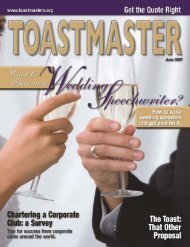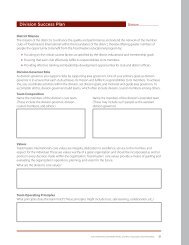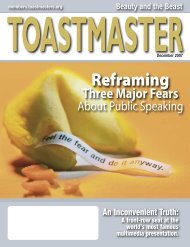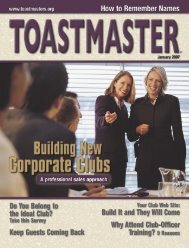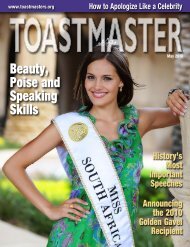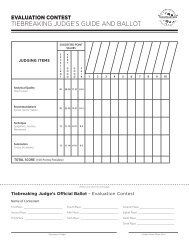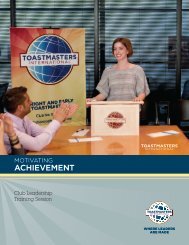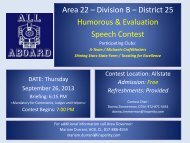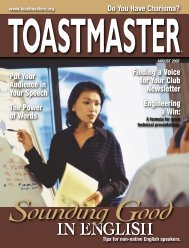September 2011 - District 25 Toastmasters
September 2011 - District 25 Toastmasters
September 2011 - District 25 Toastmasters
Create successful ePaper yourself
Turn your PDF publications into a flip-book with our unique Google optimized e-Paper software.
A BRIEF HISTORY OF THE<br />
TOASTMASTERS EMBLEM<br />
By Beth Black, CC<br />
<strong>Toastmasters</strong> around the world<br />
know the <strong>Toastmasters</strong> emblem<br />
when they see it: that familiar<br />
circle girded by two gavel heads, the<br />
impression of a map within and the<br />
bright “T” holding center court. At the<br />
top is the word “<strong>Toastmasters</strong>,” at the<br />
bottom the word “International.” The<br />
design is familiar because it represented<br />
the organization for a long time.<br />
Typically, corporate icons are not<br />
static; they evolve as regularly as the<br />
entities they represent. For example,<br />
Starbucks Coffee updated its logo<br />
this year – for the third time since its<br />
founding 40 years ago – by removing<br />
the company name from the design,<br />
leaving only the familiar image of the<br />
green mermaid. Company officials<br />
explained that the words “Starbucks<br />
Coffee” were removed because they<br />
limited the brand’s language to<br />
English and its focus to one beverage.<br />
The company’s new logo supports its<br />
plan for an expanded product line<br />
and a more prominent position in the<br />
international marketplace.<br />
Like Starbucks, <strong>Toastmasters</strong><br />
International must stay competitive<br />
and relevant on the international<br />
stage to remain successful. A fresh<br />
and consistent brand identity brings<br />
a crisp, contemporary appeal that<br />
can attract new members, supporters<br />
and media attention – a few of the<br />
many reasons <strong>Toastmasters</strong> International<br />
unveiled its brand refresh,<br />
including its new logo, in August.<br />
To understand how this organization<br />
came to be represented by the<br />
globe emblem, let’s visit past designs<br />
and the reasons they were fashioned<br />
as they were.<br />
In an article for the Toastmaster<br />
magazine published before his death,<br />
Dr. Ralph Smedley, <strong>Toastmasters</strong>’<br />
founder, discussed the emblem’s<br />
creation and its history through the<br />
1940s. “Like so many other features<br />
of <strong>Toastmasters</strong>,” he wrote, “it had a<br />
beginning long ago, and it has been<br />
subjected to repeated revisions for improvement.”<br />
The rest of Dr. Smedley’s<br />
discussion detailed that early progression<br />
– with sections quoted below.<br />
In 1928, Dr. Smedley published<br />
a mimeographed “manual” to provide<br />
information for people inquiring<br />
about <strong>Toastmasters</strong> and its benefits.<br />
For the cover, an illustration facing<br />
the title page, he designed an emblem<br />
that consisted of a gavel with<br />
the letters “T-C” entwined around it.<br />
“This was a very simple design, made<br />
simple intentionally so that it could<br />
be reproduced on the mimeograph<br />
stencil without great trouble or artistic<br />
ability,” Smedley wrote. “It served<br />
its purpose.”<br />
In 1931, the organization’s growth<br />
required that it become more formalized.<br />
“Some <strong>Toastmasters</strong> felt the need<br />
for a distinctive emblem,” explained<br />
Smedley. In January of that year,<br />
two members presented a sketch for<br />
consideration at an executive meeting.<br />
The sketch resembled the original<br />
symbol, except that the Latin words<br />
Oratores Omnes, meaning “all orators,”<br />
emblazoned the top, and the<br />
center held two letters: “T-M.”<br />
This emblem, in blue and gold, was<br />
adopted and used for 10 years. A<br />
lapel button bearing this emblem was<br />
worn by members for several years.<br />
In 1941, to update the emblem,<br />
The “T-M” in the center of the design<br />
was replaced with a single “T,” and<br />
the Latin words were removed.<br />
The words “<strong>Toastmasters</strong> International”<br />
were added. The result was the<br />
familiar emblem that the organization<br />
used for many years. The emblem will<br />
continue to remain the official seal of<br />
the organization.<br />
In August, at the <strong>Toastmasters</strong><br />
International Convention, the new<br />
logo was unveiled, but the principles<br />
behind the <strong>Toastmasters</strong> symbols<br />
and all of the organization’s branded<br />
appearance remain the same. Dr.<br />
Smedley wrote, “For the member, the<br />
TI emblem is a constant reminder<br />
of the ideals and principles of the<br />
organization. For others who observe<br />
it, the emblem suggests skill and fluency<br />
in speech.” Let every person who<br />
wears the new logo be reminded of<br />
his or her obligation to be worthy of<br />
displaying it. T<br />
Editor’s Note: To learn more<br />
about the brand refresh, visit<br />
www.toastmasters.org/where<br />
leadersaremade.<br />
Beth Black, CC, is an associate<br />
editor of the Toastmaster magazine.<br />
Reach her at bblack@toastmasters.org.<br />
TOASTMASTER SEPTEMBER <strong>2011</strong><br />
11



